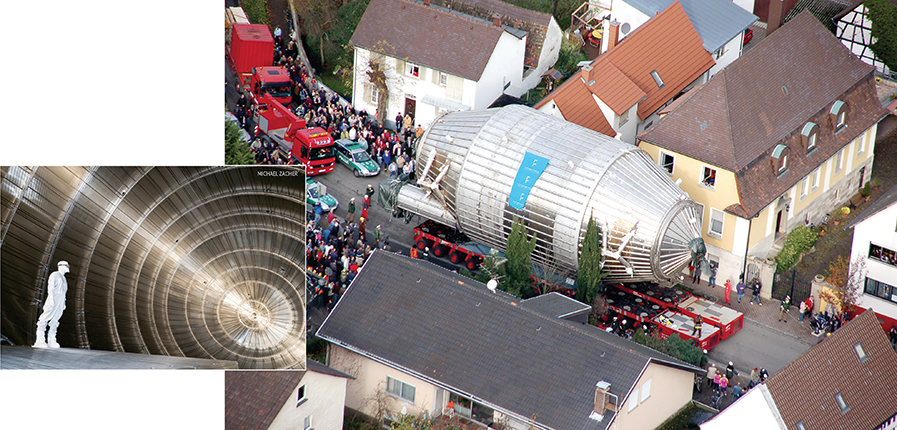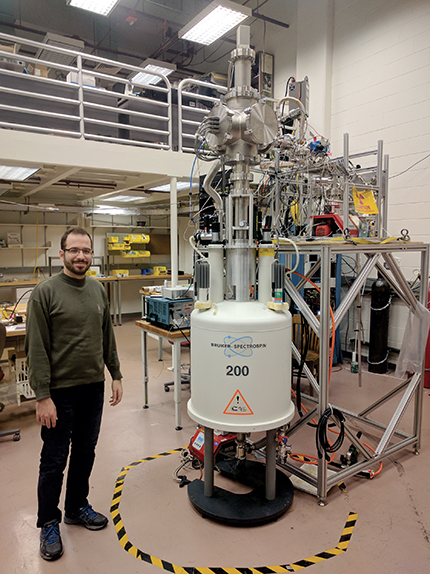Massive machine gears up to weigh nearly massless particles
DOI: 10.1063/PT.3.3656
“Neutrinos are so beautiful, so incredible. We need to understand them better,” says Guido Drexlin, project leader of the Karlsruhe Tritium Neutrino Experiment (KATRIN) in Germany. Billions of neutrinos fly by—and through—us constantly. But because those fundamental particles are neutral and weakly interacting, they remain elusive: What is their mass? What is the mass hierarchy of the three neutrino types? Are neutrinos their own antiparticles? Can they help explain the dominance of matter over antimatter in the universe? What is their role in the creation of the elements?
The gigantic KATRIN experiment at the Karlsruhe Institute of Technology (KIT) leads a new generation of varied approaches aimed at nailing down the tiny neutrino mass. Scientists are testing the apparatus now and will begin collecting data early next year.

Transporting the spectrometer for the Karlsruhe Tritium Neutrino Experiment was a difficult task and a spectacle. Its size required a detour that took it 8400 km, mostly over water, to travel to its destination just 400 km from where it was assembled. Inset: The inside of the 1400-cubic-meter spectrometer.
MARKUS BREIG/KIT. Inset: MICHAEL ZACHER

Tritium decay
With the 1998 discovery at Super-Kamiokande in Japan that neutrinos oscillate among flavors (see Physics Today, August 1998, page 17
KATRIN builds on those experiments and brings together researchers from them and related projects. Like its predecessors, KATRIN looks at electrons from tritium decay to infer neutrino mass. But with its improved detectors, it will be sensitive to a neutrino mass as light as 0.2 eV.
Tritium decays with a half-life of 12.3 years into a helium-3 cation, an electron, and an antineutrino. Together, the two leptons carry an energy of 18.6 keV. In a small fraction of the decays, the electron gets all the energy except for the rest energy of the antineutrino. Those are the decays that KATRIN homes in on: The neutrino rest mass—or, more precisely, the weighted average of the three neutrino mass states—is the difference between the energy released in the tritium decay and the maximum electron energy.
KATRIN uses gaseous molecular tritium as the beta decay source. In the isotropic decay process, electrons that fly away from the spectrometer are lost to the experiment. Those with enough forward momentum are guided toward the spectrometer by superconducting magnets. At the same time, the experiment has to prevent the tritium from reaching the spectrometer, where it would create unwanted background signals. The roughly 40-m-long path to the spectrometer has curves and pumps to intercept and recycle the tritium. “The more kinks in the path, the more chances you have to bounce the tritium into a pump,” says Carnegie Mellon University’s Diana Parno, a KATRIN member.
The “windowless” source, in which the tritium is diverted before it reaches the spectrometer, was adapted from earlier experiments at Los Alamos and Troitsk. The KATRIN team calculates that the pumps reduce the concentration of tritium at the detector by 14 orders of magnitude.
An initial spectrometer rejects low-energy electrons; information about the neutrinos cannot be extracted from them. Inside the main spectrometer, a magnetic field gradient adiabatically transforms the cyclotron motion of the surviving higher-energy electrons into longitudinal motion, parallel to the field lines. The bigger the vessel, the better and more gradual the collimation of the electrons, and the better the final energy resolution measurement, explains Parno. Scientists look at the shape of the electron energy spectrum to uncover the neutrino mass.
One out of a billion tritium atoms decays per second. With 1019 molecules injected into the KATRIN beamline per second, some 1010 electrons result. After being sorted for the highest energy electrons, “about one electron per hour will be interesting for us,” Drexlin says.
Technologies at the edge
Construction of the 70-m-long experiment came to €60 million ($69 million). Germany paid the bulk. The US put in about 10% of the total, including fabricating the detector. Scientists in the Czech Republic, France, Russia, and Spain are also on the project, with each of those countries having contributed a few percent of the experiment’s cost.
KATRIN was built at KIT because of its experience with tritium—KIT develops technologies for the fuel cycle of ITER, the international fusion test reactor under construction in France. For the neutrino mass measurement, scientists had to figure out how to determine the relative amounts of hydrogen, deuterium, and tritium in the source.
Achieving the target sensitivity required other technical innovations, including developing a cryostat to cool the tritium source gas from room-temperature to 30 K ± 30 mK. The cryostat “consists of many thousands of individual parts, each of which has to be tailored to maximize temperature stability,” says Drexlin. “Just the cryostat was a 10-year production. It is much more than a simple pipe to feed in tritium.”
Creating and maintaining an ultrahigh vacuum (10−11 mbar) in the spectrometer required new developments, as did maintaining the vessel’s high voltage—20 000 V and above, required for the selection of the high-energy electrons—to a part per million. (The spectrometer from the earlier Mainz experiment is used both for monitoring the main spectrometer for fluctuations in voltage and for training purposes.)
The spectrometer was a particular challenge. It was assembled in Deggendorf, about 400 km from Karlsruhe, but because of its size—200 tons and 10 m in diameter—it could not be transported by road. In 2006 it was sent on an 8400 km detour via the Danube River, the Mediterranean Sea, the Atlantic Ocean, the North Sea, and the Rhine River. Only the final 7 km leg from the town of Eggenstein-Leopoldshafen was overland, and that part of the journey was planned down to the last centimeter, because the enormous vessel had to skirt by houses on its way to KIT.
On site, some 43 km of stainless-steel wire were threaded in a precise pattern around the inside of the spectrometer. The wires form a shield against electrons from external sources; the shield needs to have as low a mass as possible to avoid being a source of background itself.
The experiment’s stringent requirements led to multiyear delays. “We had to push industry to the limit,” Drexlin says. “Everything has to be at the edge of what you can do—the best tritium technology, the best temperature stability, the best voltage stability, and the best vacuum stability. We have to measure over five years, and nothing is allowed to change over that time.”
“We actually had to increase the experiment’s measurement sensitivity 100 times compared to the earlier experiments,” says Parno, because the distortion of the shape of the tritium beta decay spectrum comes in as the square of the neutrino mass. “That’s why we had to work so hard” to get the factor of 10 improvement in neutrino mass.
Last fall, the first electrons were fed through KATRIN in a test of the detector and the beam transport system. And in early July, krypton-83m, a monoenergetic beta emitter, was successfully injected. “It’s a crucial test,” says Drexlin. “If you get a well-defined line, it’s all systems go. Tritium emits a broader spectrum of electrons.”
It will take years to accumulate sufficient statistics. “If nature smiles on KATRIN and the neutrino mass is large, then we can make a good measurement,” says Parno. But if the average mass is lighter than 0.35 eV, the statistics won’t be sufficient to make a strong claim. Measurements with more sensitivity will be needed.
Beyond KATRIN
Other approaches to measuring the neutrino mass that could go beyond KATRIN are already in the works. One exploits electron capture by holmium-163 embedded in a detector system that consists of a low-temperature metallic magnetic calorimeter. When 163Ho decays, an inner-shell electron is captured by the nucleus; in the capture process, an electron neutrino is emitted. The dysprosium-163 daughter atom is left in an excited state. Its relaxation is detected as an increase in temperature. By analyzing many such reactions, one can deduce the neutrino mass. That’s the idea behind the Electron Capture Holmium (ECHo) experiment in Germany and similar, less-advanced experiments in Italy and the US.

Graduate student Ali Ashtari Esfahani works on Project 8 at the University of Washington. Still in the R&D phase, the experiment aims to deduce the neutrino mass from cyclotron radiation emitted by electrons in tritium beta decay. In the prototype shown, a 1 T superconducting magnet surrounds the source, and the waveguide above the magnet carries the faint microwave chirps to an amplifier.
MARTIN FERTL/UNIVERSITY OF WASHINGTON

One advantage of the electron capture approach, says ECHo spokesperson Loredana Gastaldo of the University of Heidelberg, is that it is modular: In ECHo, a multitude of chips host 72 detector units apiece, each with about 1013 implanted 163Ho atoms. The more chips, the better the statistics. Next year, she says, ECHo will reach a sensitivity on the order of 20 eV, and “after that we will work toward a large experiment to achieve sub-eV sensitivity.” In March ECHo and KATRIN signed an agreement to share ideas.
Project 8 is a collaboration of two German and nine US institutions. Like KATRIN, it looks at electrons from tritium decay. But instead of directly measuring electron energies, it monitors the frequency of cyclotron radiation produced as the emitted electrons spiral in a magnetic field. Several features lead to a statistical advantage, says Hamish Robertson of the University of Washington. The electrons don’t have to be extracted from the tritium gas, the frequency spectrum is measured all at once rather than in small steps, and the setup intrinsically has low background. And, he says, although Project 8 will start with molecular tritium, the aim is to use atomic tritium.
Initial tests prove the concept is sound, Robertson says. “We don’t yet know the ultimate sensitivity, but we think it’s below 100 meV and maybe as small as 40 meV.” The estimated time scale for surpassing KATRIN in sensitivity is about when that project wraps up. “If KATRIN sees something, Project 8 would be a verification,” he says. “But if KATRIN sets an upper limit, [Project 8] would be a way to improve on it.”
A second, more sensitive phase for KATRIN is also being designed. “It’s possible that the neutrino mass will be too small for us to measure,” says Drexlin. “We have many ideas on how to improve the experiment.” The energy can be measured more precisely, he says. And if the source is switched to atomic tritium—which is harder to prepare—the analysis would be more precise.
Sterile neutrinos
Susanne Mertens, who with Parno and KIT’s Kathrin Valerius makes up the trio in charge of data analysis at KATRIN, calculated that the experiment could hunt for hypothetical sterile neutrinos too. If they exist, they are predicted to be heavier and at least a million times more weakly interacting than regular neutrinos. (See Physics Today, October 2016, page 15
For researchers to use KATRIN to look for sterile neutrinos, they would need to measure low-energy electrons from tritium decay alongside the high-energy ones. KATRIN’s current detector can’t handle that increased flux, but Mertens’s group at the Technical University of Munich and the Max Planck Institute for Physics is designing one that could. She has tested a prototype at the Troitsk site, where scientists are now also focused on finding sterile neutrinos.
George Fuller, an astrophysicist at the University of California, San Diego, says he was surprised that KATRIN could probe in the keV region where sterile neutrinos might be revealed. “You have good statistics and can put meaningful constraints on sterile neutrinos as a candidate for dark matter,” he says.
Neutrinos played a role in the formation of large-scale structures in the early universe, notes Parno. “It would be very exciting to connect microscale measurements to cosmological events. You don’t get a lot of chances to test cosmological parameters in the laboratory.” Another motivating factor, she says, is to try to figure out how neutrinos get their mass.
More about the Authors
Toni Feder. tfeder@aip.org
